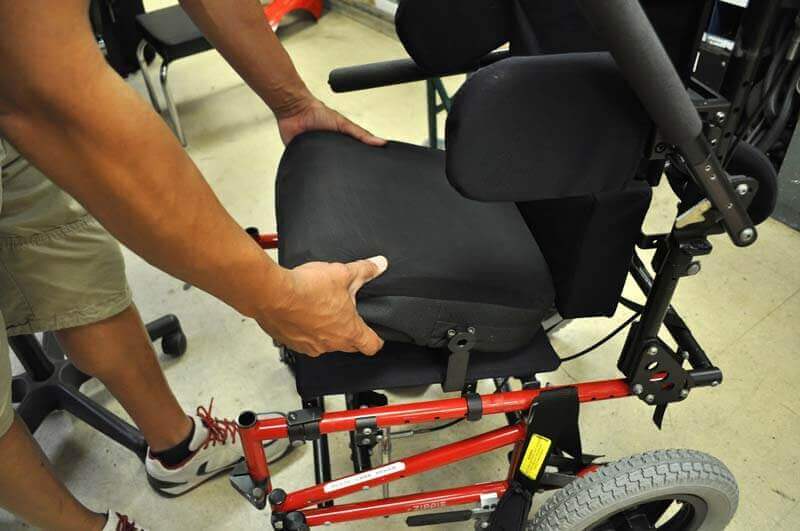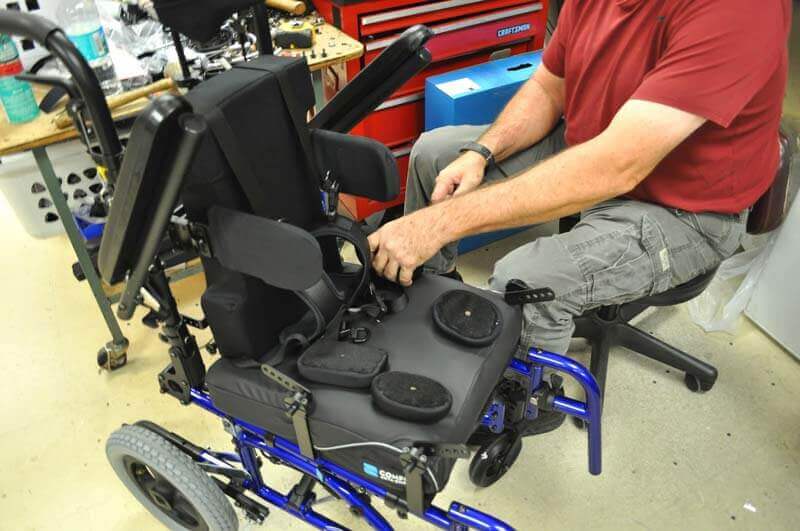When it comes to picking the right manual or power wheelchair, we're sure you've thought of things like whether you want a rigid or folding frame, do you want a mid- or rear-wheel drive chair, and even what color it should be. But what about the seating itself? Consider how many hours per day you'll be sitting on the cushion of your wheelchair. In many ways, the cushion is more important than the chair itself! But between foam, fluid, and air options, how do you know which is best for your needs?
In this blog post from Kyle Romano of Custom Mobility, you'll learn about the different types of cushion inserts on the market today, and which may be best to suit your specific needs.
When somebody mentions a seat cushion to you, what are the first thoughts that run through your mind? I imagine that most people think of comfort, right? While comfort is important, wheelchair users and their physicians need to consider much more. Let's explore the importance of choosing the proper seat cushion.
There is a large range of seat cushions, all meant to serve a wide variety of populations. How complex can it really get? It's easy to forget that wheelchair users don't merely "sit" on these devices. We live on them.
So, how do you determine the "right" seat cushion? That decision isn't made by a single person; instead, you decide on a solution with your therapist or Assistive Technology Professional (ATP). Since your needs are unique to you, your therapist or ATP will need to consider a variety of factors, including: activity level, habits, nature of limitation and condition, practicality, age, diet, and hygiene care. For additional information regarding the importance of seating, take a look at our Take a Seat blog post.

For wheelchair users, there are four main types of seat cushions: foam, gel, air, and fluid. Each of these solutions can be drastically different, and may offer solutions for particular populations of users.
Foam Wheelchair Cushions
Chances are that, if you've seen a wheelchair cushion, it was made of foam. Therapists and ATPs like these cushions because they tend to be less expensive, less complex, and lightweight. Foam is perfect for offering a stable seating surface. Often, these cushions are practical solutions for individuals who don't require much intervention in the realm of seating and positioning. They usually have the same level of density throughout the entire surface area. Foam cushions also rest on a contoured base and offer multiple levels of foam firmness. These cushions are common among manual wheelchair users, who often transfer from their wheelchairs to: cars, other chairs, and even the floor.
Gel Wheelchair Cushions
I actually use a gel cushion, which is made from a more compact material than foam cushions. This variety offers a nice, malleable surface for pressure points to rest. Sitting on top of the gel reduces shearing forces and cools the skin. While the gel is malleable, the inner material doesn't move around as well as the filling of fluid cushions. I'm pretty active and transfer from my wheelchair a number of times throughout the day. In my particular case, I required a solution that would allow me to remain active, but needed more support than a foam cushion could provide.
Air Wheelchair Cushions
Air cushions fit a very specific need. While they are the most unstable variety of seat cushion, they do offer low-impact pressure relief. What's nice about air cushions is that they tout an adjustable level of firmness. This quality can be great if the user's needs change in relation to seating and positioning. However, their upkeep may be a little more involved; it might be more difficult to maintain air pressure. They are also susceptible to puncturing, which can deflate the cells in the cushion and leave the individual without pressure relief.
Fluid Wheelchair Cushions
Fluid-based cushions are widely used, and are often confused for their gel counterparts. They don't require the level of maintenance necessary to maintain air cushions. When it comes to relieving pressure areas, fluid cushions are as efficient as air cushions. While the user sits on top of gel, they are enveloped by fluid. This feature is perfect for individuals who need to be immersed in their cushions, which offers a unique form of supporting the body.
To get the longest life out of your seat cushions, which is usually about two years, maintaining them is vitally important. Your cushion will last longer if it is kept away from fluids, which can be even easier if you use an incontinence cover. For those who use foam, gel, and fluid cushions, it's a great idea to perform a regular check for tears, rips, or any other kind of wear. For people who use air cushions, it's probably a good idea to check the air pressure daily.

At first, this information may be a lot to take in. Over time, this knowledge will certainly become second nature. If you are experiencing any difficulty concerning your seat cushion, or if you have general questions, please feel free to give Custom Mobility a call at 727-539-8119.
This blog was originally featured on Custom-Mobility.com and republished with permission.
About the Author
Around the age of one, I contracted bacterial meningitis. When I was three, I began using a power wheelchair. I've always embraced my disability and taken pride in knowing that I was different than my peers. My desire to learn more about disability led me to study critical disability theory both as an undergrad and a graduate student. I've always been passionate about gaming, which influenced me to write my Master's thesis on accessibility and video games as it relates to gamers with disabilities. In my spare time I love competing in local tournaments for Super Smash Bros., reading fantasy and sci-fi novels, and writing.
Most of the stories here on LiveQuickie.com were submitted by readers. Do you have a story to tell? We'd love to hear it. Submit your story here.